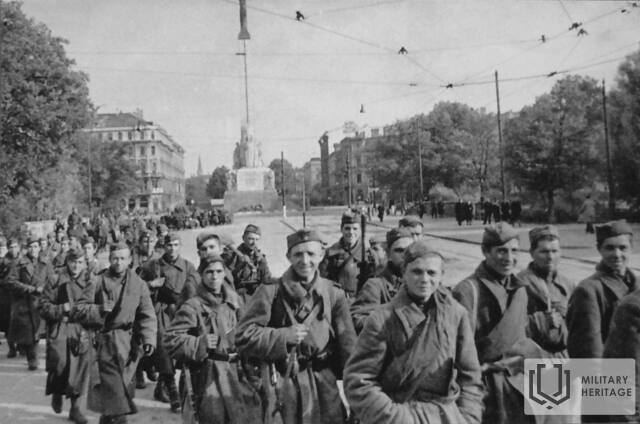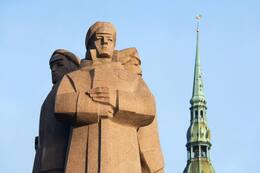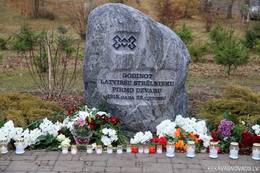Latvians in the Russian Imperial Army

The territory of Latvia had been part of the Russian Empire for over a hundred years at the beginning of World War I. Latvians participated in all the major wars of the Russian Empire, but direct military action had not taken place in Latvia for over a hundred years, since the invasion of Napoleon's army in the early 19th century. In 1914, with the outbreak of World War I, the territory of Latvia was also affected by mobilization and young men from the age of 18 began to be called up for military service. After the general mobilization, the size of the Russian Empire's army increased almost 4 times.
The origins of the Russian Empire's army can be traced back to the Great Northern War (1700-1721), when changes were constantly made to the army to improve its combat capabilities. With the victory in this war, the Russian Empire was founded, which included the territory of the former Russian Tsardom and the territories conquered in the 18th-19th centuries, including Latvia and Estonia. Military reforms continued in the Russian Empire's army, and the introduction of a recruitment system was also initiated in the territory of Latvia. In the second half of the 19th century, many young Latvians and Estonians began studying in Russian military schools, as education there was free and it was a way to secure a place in society. Many of them became officers and generals.
The war effort brought by World War I reached the territory of Latvia already in the first days after the start of the conflict. For its inhabitants, the involvement of the Russian Empire in the war first meant mobilization, the expropriation of food, clothing, fuel and means of transport, and the subordination of all civilian life to the needs of the war. General mobilization, which began in full force in the Russian Empire on July 31, 1914, took place according to the regulations of 1910, conscripting men aged 18 to 43. In total, mobilizations took place seven times in the territory of Latvia during the war years, mobilizing 120-140 thousand people. Latvian soldiers were included in the Russian military units deployed in the territory of Latvia.
The 20th Army Corps (sometimes referred to in literature as the "Latvian Corps") was one of the most combat-ready units of the Russian army, which was involved in fighting in East Prussia shortly after the start of the war. Despite initial successes, the Russian army suffered defeat and was forced to retreat. In February 1915, the 20th Army Corps suffered a catastrophe when the Germans surrounded and destroyed it in the Augustów Forest (in present-day northeastern Poland). 15-20 thousand soldiers mobilized in the Baltic provinces (Estonia, Vidzeme and Courland) lost their lives, went missing, and were taken prisoner, most of them Latvians.
With the order of August 1, 1915 to form Latvian rifle units in the Russian Imperial Army, 8 rifle battalions were formed, which went into their first battles already in October 1915. After the end of World War I, some Latvian riflemen remained in Russia and fought in the Civil War on various sides of the front, some participated in the Freedom Struggles in Latvia. In 1921, with the onset of peace, a large number of former riflemen who had spent the last five years fighting returned to Latvia.
More information sources
1. Blizzard of Souls. Digital Museum. Available: https://www.dveseluputenis.lv/lv/laika-skala/notikums/64/1.-pasaules-kara-sakums-latvija/ [accessed: 01.04.2021.].
2. Jēkabsons, Ē. LA.LV publication “From the sons of peasants to the Tsar’s officers”, 2014. Available: https://www.la.lv/no-zemnieku-deliem-par-cara-virsniekiem [accessed: 01.04.2021.].
3. Zariņš K. Latvian War Museum publication “1914: mobilization and battles in East Prussia”, 2014. Available: http://www.karamuzejs.lv/lv/Petnieciba/publikacijas/01_1914gads.aspx [accessed: 01.04.2021.].
4. Zariņš K. “The First World War in Latvia and the Battles of Latvian Riflemen”, 2015. Available: https://www.sargs.lv/lv/pirmais-pasaules-kars/2015-07-15/pirmais-pasaules-kars-latvija-un-latviesu-strelnieku-cinas [accessed: 05.05.2021.].
Related timeline
Related objects
Latvian Riflemen Monument in Riga
Located in the center of Riga, on Latvian Riflemen Square near the Latvian Occupation Museum.
The monument to the Latvian Riflemen was unveiled in 1971 in Latvian Riflemen Square next to the former Latvian Red Riflemen Museum (now the Museum of Occupation). During the Soviet era, the topic was viewed through the narrow ideological prism of the communist regime. The place served to represent Riga and create an idealized story, reinforcing the myth of Latvians as fighters for Soviet power.
Light infantry units in the Russian army were called riflemen. During World War I, Latvian rifle formations were created to fight against the German army in the homeland. They were motivated, dangerous and disciplined combat units. The high level of education and knowledge of the German language were useful for reconnaissance and conducting surprise attacks. With the collapse of the Russian Empire and the complete occupation of Latvian territory by Germany, a very large number of Latvian residents ended up in Russia, where they continued to face Bolshevik agitation. Initially, support for Lenin's ideas and participation in the Russian Civil War grew. Later, disillusionment followed, and most Latvian soldiers turned away from leftist ideas and returned to Latvia. Most of the soldiers who remained in Russia were killed during the "Stalin purges" (1936-1938). Latvian riflemen made great contributions to the creation of the Latvian state and its army.
Today, you can visit the monument and the adjacent Occupation Museum.
Memorial stone for Latvian riflemen in Plakanciems
In Plakanciems, the Latvian riflemen won their first victory in the historic night battle of October 29, 1915 – just a week after the 1st Daugavgrīva Latvian Riflemen Battalion had left Riga and started operating at the front. With the successful Battle of Plakanciems, the heroic path of our riflemen began. The night attack on the Misa River also had an invaluable moral significance – no one doubted the fighting abilities of the Latvian riflemen, they quickly became popular and many Latvians from Russian regiments joined our national units.
The memorial stone was created by the Ķekava municipality by the Ķekava municipality stone processing and restoration company "Akm Stone Processing Center" - stone craftsmen Guntis Pandars and Pēteris Zvaunis.
The success in the Battle of Plakanciems was ensured by careful continuous reconnaissance lasting four days, a surprise attack plan drawn up by the commander of the 1st Company, Fridrihs Briezis, and the heroism of our soldiers.
The situation on the front was very tense at that time, as German soldiers slowly continued to approach Riga in several places. Near Plakanciems, they had recently crossed the Misa River and begun to establish a bridgehead position, deploying the 2nd Battalion of the German 376th Infantry Regiment and 4 machine guns.
The Latvian riflemen's attack was based on surprise, quick action and coordination of various actions. Each rifleman of the 1st company was given four hand grenades, 60 soldiers put on white cloaks, because a thin snow had just fallen. When the attackers crept close enough to the German positions, at 22:00 the signal was given and the attack began. Both of our machine guns fired at both flanks of the enemy so that the Germans could not attract reserves. Throwing hand grenades, the Latvian riflemen quickly stormed the German trenches, Russian artillerymen fired at the bridges of the Misa River and the enemy's main defense line. The enemy soldiers were confused - suffering heavy losses, they retreated across the river and left the bridgehead in the hands of the attackers. One of our companies had defeated an enemy unit four times larger!
The Latvian riflemen lost six fallen soldiers – Juris Butenieks, Frici Ērmanis, Rūdolfs Hofmanis, Kristaps Krūmiņš, Jānis Nauris and Kirijans Šnurovas. They were all buried in the Riga Brothers' Cemetery. Of the eight wounded, two later died – Jāzeps Brūveris (buried in the Pleskodāle Cemetery) and Jānis Skuja (buried in the Riga Brothers' Cemetery). German losses – 31 soldiers killed, 34 taken prisoner and 45 wounded. The attackers took a machine gun and 35 rifles as trophies.
The cemetery of the brothers of the Latvian riflemen who fell in World War I and the soldiers who fell in the War of Independence
Located in the Valmiera City (Center) Cemetery, Lillijas Street 7.
A granite obelisk can be seen, the details of which were forged by sculptor Wilhelm Trey.
The monument was unveiled on June 22, 1923. About 150 soldiers are buried in the fraternal cemetery.
Several fighters of the First World War and the War of Independence are buried in the city cemetery, including the first casualty of the Cēsis Regiment's School Company, LKOK Edgars Krieviņš.
Currently, the section of the fraternal cemetery contains 14 groups of graves of various lengths, on which 139 white wooden crosses have been installed, but the plaques with the names of the fallen, which used to be on the crosses, are no longer there. One black granite cross has survived.
During the communist occupation, intensive civilian burials were carried out in the section of the fraternal cemetery. After the restoration of independence in 1994, the burial layout in the fraternal cemetery was changed, and the grave groups are now arranged crosswise, with only one retaining its former orientation.
Related stories
A commemorative badge dedicated to Admiral Makarov was found in the yard
A small military relic can tell a vast historical story. And although the badge represents events that took place during the Russo-Japanese War, it also shows the colorful military history and the involvement of our Latvian Riflemen in other military conflicts, both before and after the Wars of Independence.






